Last Updated on October 2, 2023
A garden herbs list with pictures.
Learn about 40 types of herbs you can grow in your garden.
First, I’ll present you with an alphabetical list of herbs for your garden, so you can see at a glance what you can grow:
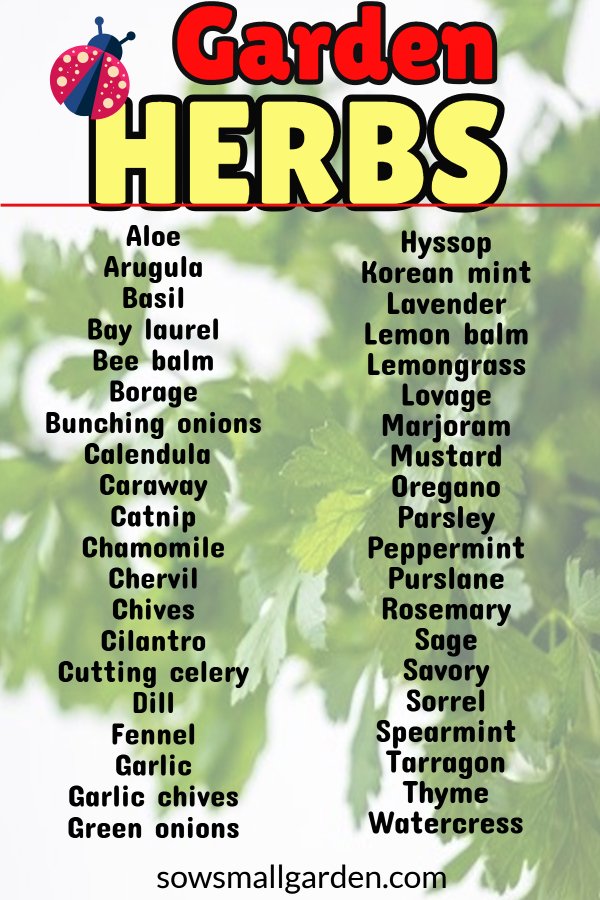
This post may contain affiliate links which means that if you click and make a purchase through the link – I earn a commission at NO extra cost to you.
And now, let’s learn how to plant and grow these culinary and healing types of herbs in your outdoor or indoor garden, as well as how to use them.
1. ALOE VERA

- Latin name – Aloe barbadensis miller
- Perennial
- Succulent
- Growing requirements: aloe plant is not frost tolerant. You can grow aloe outdoors in zone 9-11 in the U.S.A. The best idea is to grow this plant in a container, so you can keep it outdoors in summer time and bring the plant indoors in sunny location in winter time.
- Propagation: buy your first aloe plant at a nursery. When the plant matures it will create offshoots from the parent plant. When the offshoot creates a few leaves of its own and reaches a size of 1/5 of parent plant – it can be separated from parent plant in its own container.
- Benefits: aloe vera provides 20 of the 22 human required amino acids and 7 of the 8 essential amino acids, vitamins, fatty acids, minerals.
- Uses: aloe was used for centuries for its health, beauty, medicinal and skin care properties. Heals wounds. Treats dermatitis. Protects from sun radiation. Read about health benefits of aloe vera here.
- Where to buy: get a live aloe vera plant from Amazon, or buy it from local nursery, floral department of hardware store (like Lowes or Home Depot) or grocery store.
Wondering if echinacea is an herb and if garlic is a spice? Are herbs considered vegetables?
Read my article “What are herbs” to get all your confusing herb-related questions answered.
2. ARUGULA
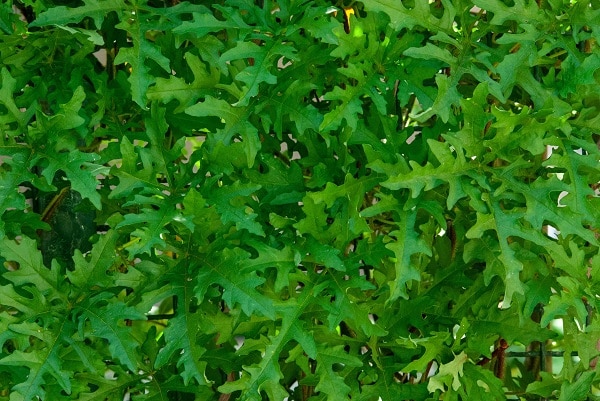
- Latin name – Eruca vesicaria
- Annual
- Growing conditions: arugula likes sun to partial shade. Grows best on fertile soil, but can tolerate poor soil. Be sure to provide adequate moisture for this plant.
- When to plant: early in spring as soon as the soil can be worked. Arugula can tolerate light frost. Sow again in late summer for fall harvest. Arugula is a great candidate for successive planting too.
- How to plant: if sowing in rows, plant seeds 1/4 inch deep in soil, 1 inch apart with 10 inches distance between rows. Or broadcast arugula seeds in one square of your square foot garden or garden planter.
- Propagation: by seeds. Once planted, leave one arugula plant to bolt and make seeds. Then harvest them or let the plant reseed itself.
- Days to maturity when planted from seed: 28-40 days
- Uses: leaves and flowers of arugula are edible. Leaves can be added to salads, omelets, sandwiches, pizza topping, sauces, pasta, or to garnish dishes.
- Best varieties to buy: Rocket, Slow Bolt, Astro, Garden Tangy
You can grow herbs indoors in an Aerogarden.
Read my article on how to get the best Aerogarden for your needs.
3. BASIL

- Latin name – Ocimum basilicum
- Annual
- Growing conditions: basil likes sun, but will grow in partial shade. Prefers well drained, yet moist soil. Not frost tolerant.
- When to plant: sow seeds or transplant basil plants after danger of frost has passed. Basil likes warm soil: when planted too early, the plant will be stunted and not productive.
- How to plant: sow seeds 1/4 inch deep 10 inches apart. Or transplant your basil plant in one square of your square foot garden. Basil will perform well in a container garden. You don’t need many basil plants, unless you make lots of pesto.
- Propagation: by seeds or cuttings.
- Days to maturity when planted from seed: 55-60 days
- Tips on growing: keep harvesting basil leaves and prune often, so plant can produce continuously.
- Uses: in culinary: pesto, in pasta sauces, dressings, vinegar; use a few torn up leaves for salad or pizza topping; goes good with fresh mozzarella and tomatoes. For medicinal uses: great antioxidant, protects against skin aging, supports cardiovascular health, reduces inflammation, eases anxiety (read more here).
- Best varieties to buy: Genovese, Sweet, Pesto Party.
4. BAY LAUREL
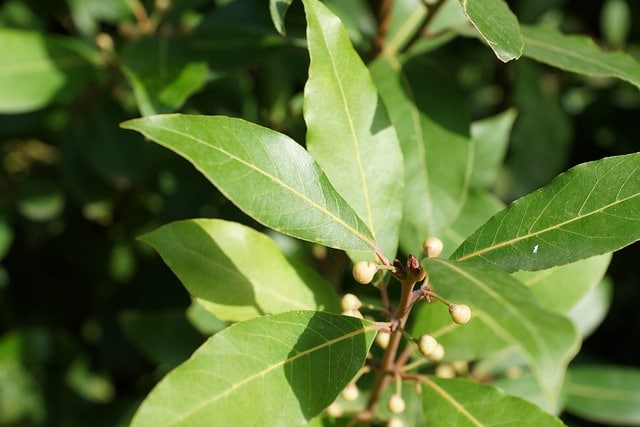
- Latin name – Laurus nobilis
- Evergreen tree
- Hardy in zones 8-10 (in the U.S.A.). Grows well in containers (outdoor and indoor). You can keep bay laurel as a houseplant, but be aware that its leaves are toxic for dogs and cats
- Easy to care for, requires very little maintenance
- Growing conditions: bay laurel likes sun to partial shade, and moist, well drained soil. This plant can withstand temperatures down to -5°C (23°F).
- Propagation: can be grown from seed, or propagated from cuttings or by layering.
- Uses: very fragrant leaves add an earthy flavor to soups, stews and sauces. You also can use bay leaves and branches in garlands and wreaths.
- Where to buy: you can get live potted plants shipped to your door from Amazon, Burpee (as potted gift), or from local nursery. Alternatively, you can try to grow bay laurel from seeds.
5. BEE BALM

- Latin name – Monarda
- Also known as: bergamot, Oswego tea
- Perennial
- Growing conditions: bee balm will grow well in sunny location and well drained soil. Soil should be kept moist.
- How to plant: sow seeds in a weed free area 1/4 inch deep after danger of frost passed.
- Flowering time: mid summer to early fall.
- Tips on growing: pinch off the top of the plant during growing season to encourage branching and make the plants look “bushier”, “deadhead” spent blooms.
- Bee balm spreads easily and can become invasive.
- Propagation: by seeds, cuttings, or by division of spreading roots.
- Uses: leaves and flowers of Monarda didyma can be used to make tea; fresh bee balm flowers are edible, you can add petals to salads.
- Best varieties to buy: Jacob Cline (intensely red), Cranberry Lace (potted plant, rosy pink, very compact), organic wild bergamot seeds.
6. BORAGE
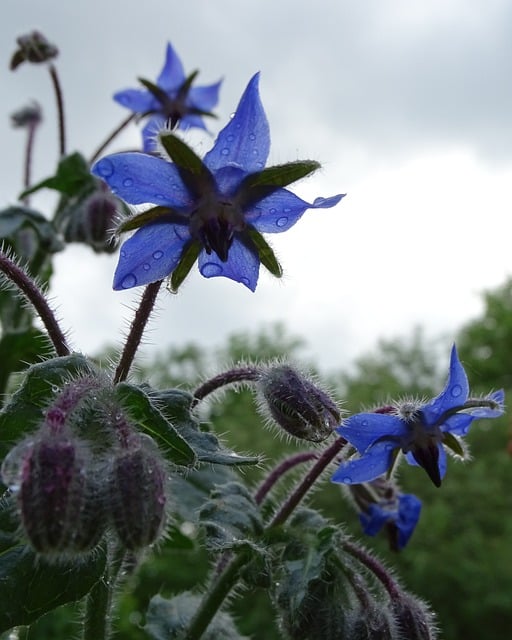
- Latin name – Borago officinalis
- Annual
- Growing conditions: grows well in full sun and partial shade in average soil. Keep plant well watered during growing season.
- How to plant: direct sow after danger of spring frost. Sow seeds about 12 inches apart, ¼ inch deep in soil.
- Plant height: 18 inches.
- Propagation: by seeds. Borage will self seed readily.
- Days to maturity when planted from seed: 50-80 days. Blooms in 7 weeks after planting.
- Uses: in culinary – young borage leaves are used in salads and lemonade. Leaves also can be cooked like spinach. The flowers are edible and can be candied. In medicine: borage flowers and leaves are used for fever, cough, and depression, and the oil from its seeds is used for skin disorders. Read more here.
- Flowers are fragrant.
- Leaves taste like cucumber.
- Perfect for edible garden.
- Where to buy: Burpee, Amazon.
7. BUNCHING ONIONS
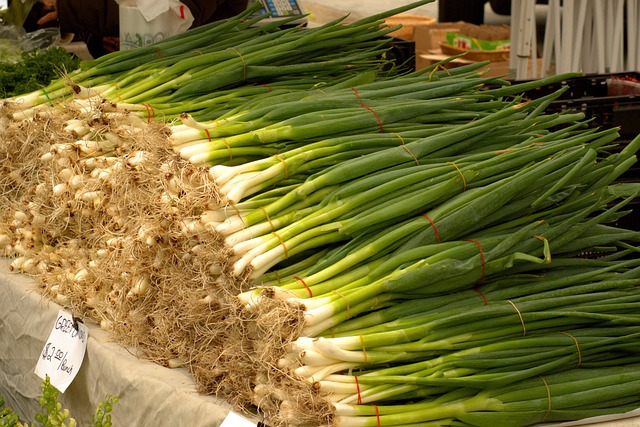
- Latin name – Allium fistulosum
- Also known as: Welsh onion, long green onion, Japanese bunching onion, spring onion.
- Perennial
- Never form bulbs
- Growing conditions: likes sunny location and well drained soil. Needs frequent watering.
- How to plant: grows easily from seeds planted 1/4 inch deep 1 inch apart.
- When to plant: in early spring or late summer. Can be used for successive planting.
- Days to maturity: 60 days.
- Propagation: by seeds, transplants or by division.
- Uses: add to salads, spreads, soups, stews and sauces. Place alongside with kabob and other meets or with baked potatoes.
- Best varieties to buy: Evergreen Long White, White Lisbon, Parade.
8. CALENDULA
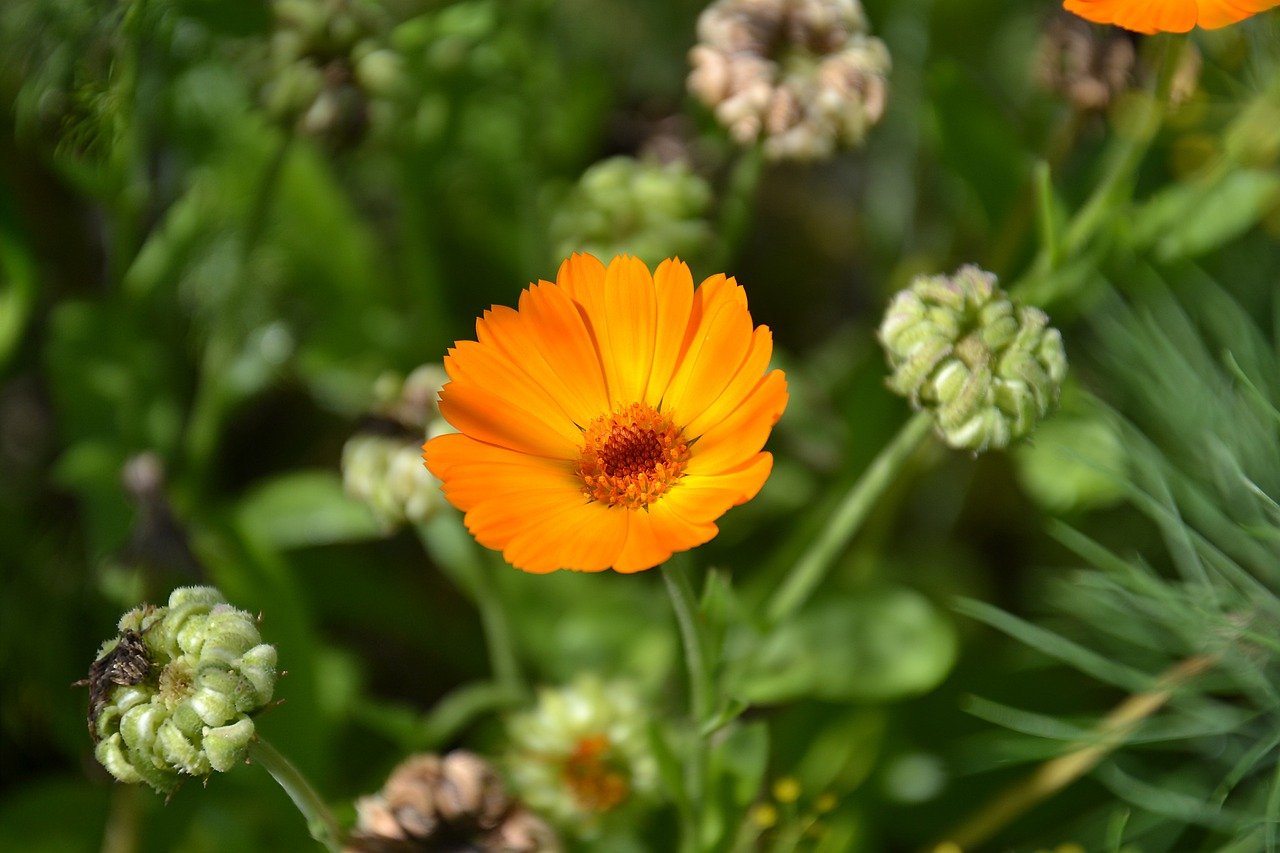
- Latin name – Calendula officinalis
- Annual
- Growing conditions: calendula prefers sunny location, will grow in average soil.
- How to plant: direct sow seeds after danger of heavy frost, or plant seeds indoors in February and transplant seedlings outdoors in April.
- Blooming time: from June till frost.
- Propagation: by seeds. Seeds can be planted twice a year. (read more here). Calendula likes to reseed itself.
- Days to maturity when planted from seed: 45-55 days.
- Uses: petals can be used in salads and teas. Calendula is a must heve first-aid herb that reduces inflammation, decreases swelling, and promotes wound healing. It is known for its antiviral, antibacterial, antifungul and anti-inflammatory healing properties. And the best thing is that you can grow calendula in your garden and make remedies from calendula flowers at home.
- Best varieties to buy: Sherbet, Resina, Pacific Beauty, Octoberfest, Ball’s Orange.
Read more articles about calendula:
- How to grow calendula
- 3 Must-Have Medicinal Plants
- Calendula Healing Properties
- Calendula Recipes: 4 DIY Remedies for Home Use
9. CARAWAY
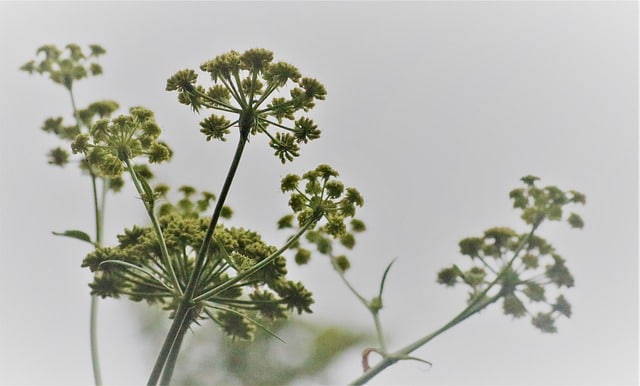
- Latin name – Carum carvi
- Biennial
- Growing conditions: caraway will grow well in full sun. It thrives in well drained, yet moist soil. Prefers cool climate.
- How to plant: sow seeds 1/2 inch deep 8 inches apart after danger of frost has passed.
- Propagation: by seeds or cuttings. Remember that seeds are produced on the second year plant.
- Uses: whole caraway plant is edible, but the seeds (which are actually fruits) are known the most. In culinary– caraway seeds are used in bread baking, also for flavoring sausages, soups, and vegetables. They go especially good with raw cabbage (like in this Festive Coleslaw recipe) because they aid digestion. Medicinal uses: caraway seeds prevent bloating, gas, indigestion, and according to scientific study can be used in treatment of non-ulcer dyspepsia. In beauty products: seeds are used as fragrance in toothpaste and soaps.
- Where to buy: Amazon.
10. CATNIP

- Latin name – Nepeta cataria
- Also known as: catwort, field balm
- Perennial
- Growing condition: catnip likes sun to partial shade and will grow in almost any soil. In sandy soil, its aroma increases. Very hardy plant. Well suited for growing in pots and hydroponics.
- How to plant: direct sow seeds after danger of frost. Cover seeds with 1/4 inch of soil. Catnip also can be started indoors in February and then replanted into the garden.
- Growing tips: cut the last years spent stems in early spring so the new ones can grow.
- Remember that catnip is invasive, so try to contain it in a small raised bed or pot.
- Propagation: by seed, stem cuttings, or root division. Self sows freely.
- Culinary uses: leaves can be used to make tea, they also can be added to salads or to flavor foods.
- You can also grow catnip for your feline friend😺, just be aware that not all cats respond to catnip, it depends on whether or not they have the hereditary gene. So don’t get disappointed if your cat doesn’t care for it.
- Catnip is good mosquito repellent.
- Medicinal uses: calms anxiety, helps for indigestion, eases colds, lowers fever. Read more about catnip uses and side effects at WebMd
- Where to buy: Amazon, Burpee.
11. CHAMOMILE (GERMAN)

- Latin name – Matricaria recutita L
- Annual
- Growing conditions: tolerant to any type of soil. Likes full sun and cool weather. Frost tolerant. Outdoor temperature and light conditions have great effect on chamomile essential oils.
- How to plant: chamomile can be grown by direct sowing of seeds and by starting seeds indoors and then transplanting. Seeds are very tiny and hard to start by planting in open soil. The optimum temperature for good seed germination is between 50°F and 68°F. If you decide to grow chamomile by direct sowing, scatter the seeds in prepared weed free soil, slightly pat them with palm and gently water. Keep soil moist till seeds germinate. After plants are established, they self sow freely.
- Propagation: by seeds.
- Gardening tip: growing chamomile near strawberries, improves flavor of strawberries.
- Medicinal uses: chamomile is known for its anti inflammatory, antiseptic, and antispasmodic properties. Chamomile tea made from flowers is used to ease digestive ailments, helps to relax and fall asleep, soothes sore throat. (Note: some people have allergic reaction to chamomile).
- Other uses: the chamomile oil is used in perfumery, cosmetics, aromatherapy, and in food industry.
- Word of caution: the true chamomile is often confused with Anthemis cotula, a poisonous plant.
- Where to buy: seeds, organic dried chamomile flowers, organic German chamomile essential oil, chamomile tea.
12. CHERVIL
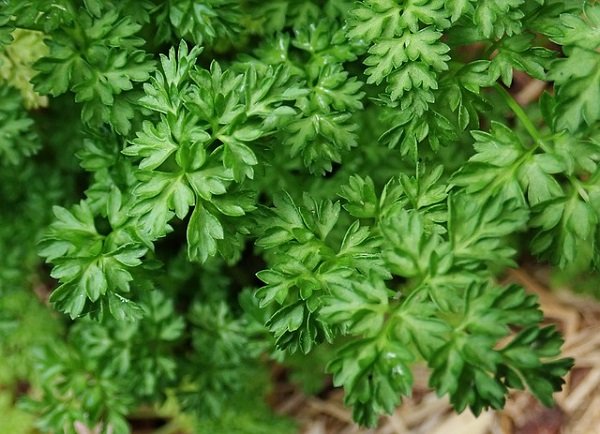
- Latin name – Anthriscus cerefolium
- Annual
- Growing conditions: prefers rich soil and cool weather, that is why it grows the best in zones 3-7 (U.S.A.). Chervil will bolt in hot weather. Hardy.
- How to plant: chervil transplants poorly, it’s better planted in open ground in early spring or fall. Sow seeds 1/4 inch deep or scatter them and cover with 1/4 inch of soil.
- Propagation: by seeds. If you allow a plant to bolt, it will self sow.
- Days to maturity when planted from seed: 6-8 weeks.
- Uses: chervil adds anise flavor to recipes. Great for salads and garnishes. When cooked – loses flavor. Use fresh chopped leaves to top omelets, grilled meats, fish, roasted or steamed vegetables, or add to butter.
- Best varieties to buy Vertissimo, Fine Curled, Outsidepride.
13. CHIVES

- Latin name – Allium schoenoprasum
- Perennial
- Growing conditions: chives like full sun and well drained soil. Good for growing indoor too. Cold tolerant. Can be invasive.
- How to plant: sow seeds as soon as the soil can be worked in the spring. If you started seeds indoors – plant transplants outdoors once the threat of frost has passed.
- Propagation: by seeds or by division of clumps.
- Days to maturity when planted from seed: 80 days. You can start harvesting chives when 6 inches tall.
- Culinary uses: leaves, flowers and flower buds can be used. Chives make a great addition to salads, soups, cottage cheese or ricotta, dips, or butter. Flowers have milder flavor and can infuse oil which will become lilac in color and can be used on salads. Flower buds can be pickled. You can freeze chives.
- Medicinal uses: eases stomach distress, helps body to digest fat, stimulates appetite, clears stuffy nose, prevents bad breath, protects heart. Read more about healing properties of chives here.
- Where to buy: chives seeds for planting on Amazon
14. CILANTRO
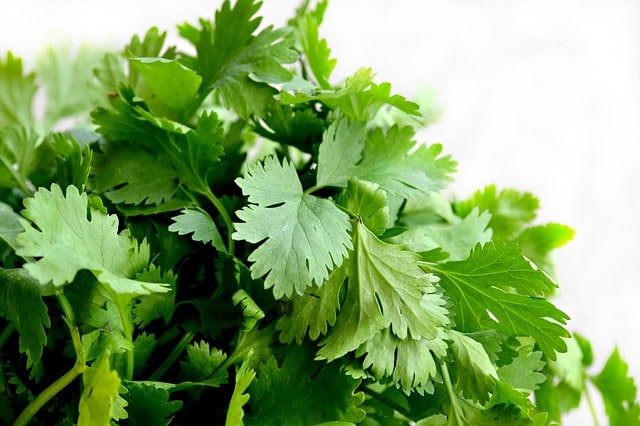
- Latin name – Coriandrum sativum
- Annual
- Growing conditions: cilantro will grow in full sun to partial shade. It prefers rich, well drained soil. Cilantro likes lots of water and can tolerate light frost.
- How to plant: cilantro doesn’t take transplanting well. That is why it’s better to sow seeds directly outdoors after danger of frost has passed. You can plant seeds 1/2 inch deep in the soil, or just broadcast seeds onto prepared soil (or in one square of square foot garden, or in container). Then rake soil surface lightly to cover seeds. You can use back of rake or your palm to tamp seeds in place.
- Propagation – by seeds. Let a few cilantro plants bolt, produce seeds and self seed in order to have a steady supply of cilantro next year.
- Days to maturity when planted from seed: 60-90 days.
- Culinary uses: leaves and seeds are used. Seeds, as spice known as coriander, are used in curry, marinades, and as a pickling spice. Seeds can even be sugar-coated and eaten as candy. Cilantro leaves are added to salsa, salads, go well with mashed avocado.
- Medicinal uses: seeds are used for indigestion, may help lower blood sugar, detoxify body from heavy metals, fight infections, good for heart and brain. For more details, read this article.
- Other uses: used in cosmetics and soaps as a fragrance.
- Best varieties to buy: Calipso (slow bolt), Confetti, Organic.
15. CUTTING CELERY
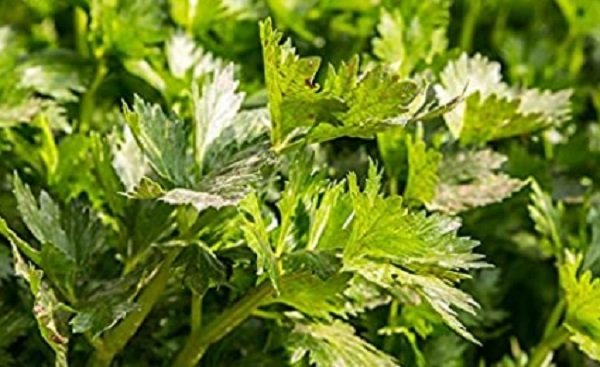
- Latin name – Apium graveolens
- Biennial
- Much easier to grow than standard celery.
- Great cut-and-come-back plant.
- Looks almost as flat leaf parsley but tastes like celery.
- Growing conditions: likes sun to partial shade. Keep it well watered.
- How to plant: direct seed in spring after the last frost. Can be started indoors and then replanted. Sow shallowly because seeds require some light to germinate.
- Propagation: by seeds. Seeds produced on the second year plant spread easily, you will get continuous supply of volunteer plants year after year.
- Days to maturity when planted from seed: 80 days, but you can start to cut it for salads in 45 days
- Uses: leaves used in salads, soups, sauces, and stews – anywhere you need a celery flavor. The ground seeds make a great seasoning for lots of dishes.
- Where to buy: non GMO seeds on Amazon
16. DILL

- Latin name – Anethum graveolens
- Biannual has often grown as annual
- Growing conditions: dill likes full sun and well-drained yet moist soil. It doesn’t do well in extremely hot or cold weather.
- How to plant: dill transplants poorly, so it’s better to sow it directly in the garden. Plant seeds shallowly or broadcast them in a weed free area, rake in order to mix up with the soil, and temp with your palm. Don’t forget to water. Sow dill seeds every 2-3 weeks for continuous harvest.
- Propagation: by seeds. Dill self-sows easily. If soil is left undisturbed around mature dill plant that produces seeds – you will get plenty of volunteer plants.
- Days to maturity when planted from seed: 8-10 weeks after sowing outdoors.
- Culinary uses: leaves, stems, seeds and flowers can be used in cooking. Dill leaves add freshness to summer salads, sauces, and soups. Dill foliage goes good with salmon and deviled eggs. Dill stem and seeds can be used for tomato and cucumber pickling.
- Medicinal uses: dill seeds are used primarily. Seeds contain chemicals that might help to relax muscles, fight bacteria and increase urine production. Tea made from seeds helps for colic and digestion problems. Dill is also used to treat urinary tract disorders, infections, and liver problems.
- Best varieties to buy: Bouquet, Mammoth Long Island, Dukat, Hera.
Read related:
17. FENNEL

- Latin name – Foeniculum vulgare
- Perennial, often grown as annual
- There are 2 types of fennel: Foeniculum vulgare produces lots of foliage and seeds, is used to flavor dishes, and is grown as herb. Foeniculum vulgare azoricum is grown for its bulb that can be cooked as a vegetable.
- Growing conditions: fennel likes full sun and rich, well-drained soil. Drought is tolerant. Also, can tolerate light frost.
- How to plant: sow seeds shallowly (not deeper than 1/4 inch) as soon as soil can be worked. It’s better to plant fennel seeds in open ground, because fennel transplants poorly.
- Fennel reaches 3 – 5 feet at maturity, so be sure to leave ample room for this plant.
- Fennel looks great at edible garden.
- Propagation: by seeds. Reseeds easily.
- Days to maturity when planted from seed: you can start to harvest foliage in about 45 days.
- Uses: use fresh fennel leaves in salads or with eggs, fish, and sauces. Fennel seeds are often used to make sausage or in other
savory dishes. They are great as a pizza topping when paired
with goat cheese, thinly sliced prosciutto, fresh fig and spicy
arugula. - Where to buy: Amazon.
18. GARLIC
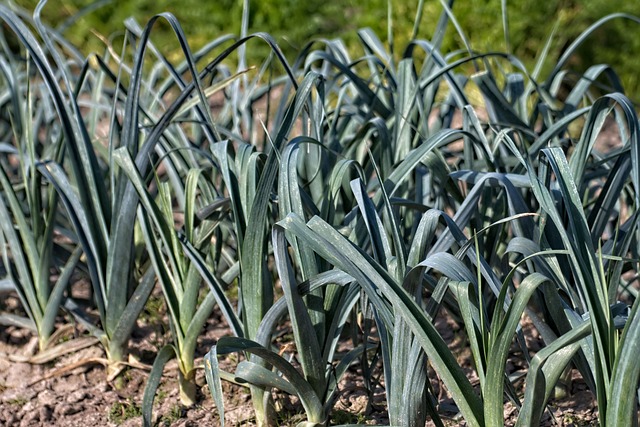
- Latin name – Allium sativum
- Also known as soft-neck garlic
- Perennial grown as annual
- This garlic is great for braiding, its tops flop over when they dry.
- Growing conditions: garlic likes full sun and well drained soil.
- How to plant: plant garlic in mid autumn or early spring as soon as soil can be worked. Separate garlic bulb into individual cloves and push them into ground 2 inches deep and 6 inches apart.
- When garlic tops begin to die, stop watering, so the bulbs can mature.
- Harvest garlic when 75% of leaves turn brown. Lay whole plants for several weeks in dry, dark place to cure. Store in 32F-35F
- Propagation: plant individual cloves.
- Culinary uses: greens and bulb can be used. Tender young garlic shoots are edible and can be used in salads, soups, sauces. But most likely you will use peeled garlic cloves to flavor vinaigrettes, marinades, salad dressings. You will want to use garlic in meat dishes, souses, soups, stews, add it to roasted vegetables.
- Medicinal uses: garlic is famous for its antioxidant, antibacterial, antiviral and anti inflammatory properties. It’s often used as home remedy for common cold. Garlic is known for boosting immunity, reducing high blood pressure, and lowering cholesterol. Read a review of its therapeutic benefits here.
- Where to buy: Amazon
19. GARLIC CHIVES
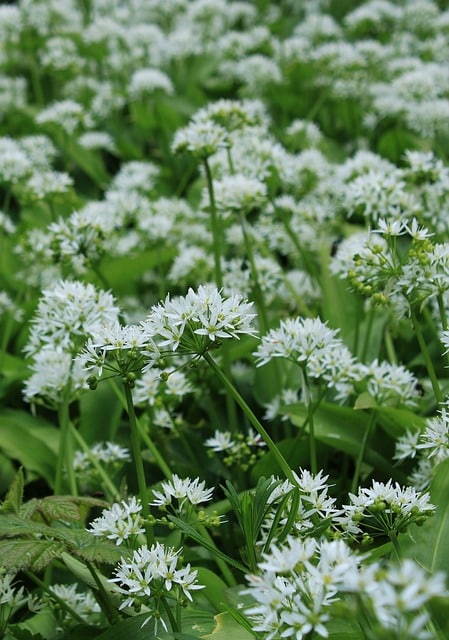
- Latin name – Allium tuberosum
- Also known as Chinese chives or Chinese leeks.
- Perennial
- Garlic chives make attractive snowy white edible flowers that bloom through summer. The plant looks great in an edible landscape.
- Growing conditions: likes sun to partial shade, well drained soil. Drought resistant. Tolerates light frost.
- How to plant: sow seeds outdoors 1/4 inch deep after danger of frost. Or sow seeds indoors in February and transplant chives outside after frost.
- Propagation – by seeds or by division of clumps. Deadhead flowers so they will not make seeds, because garlic chives are self sowing aggressively.
- Days to maturity when planted from seed: 80-90 days
- Culinary uses: Garlic chives tastes like onion and garlic combined. Flat grass looking leaves are used in Asian cooking (dumplings, dipping sauces, pot stickers). Garlic chives also taste good in egg dishes, salads, spreads, soups, marinades, vinegar. You can also pickle it’s flower buds.
- Where to buy: Amazon, Burpee.
20. GREEN ONIONS
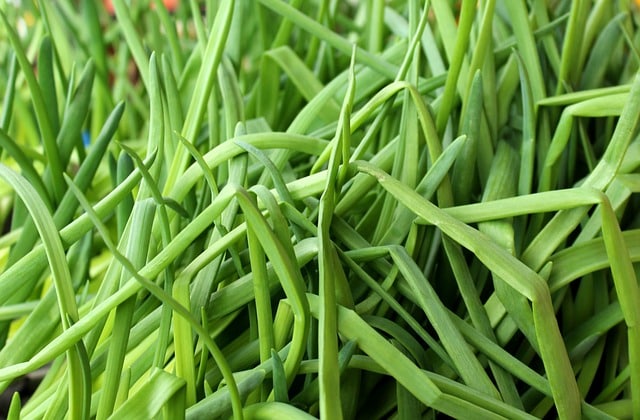
- Latin name – Allium cepa
- Annual
- Growing conditions: onion likes full sun, but can take partial shade too. Need to be watered frequently.
- How to plant: if you grow green onions from onion sets or transplants, then plant them as soon as the soil can be worked in spring 1 inch apart. Push each bulb into the soil, so the pointed tip just slightly shows above the ground. (Read more on how to grow onion from sets here). If you are growing onion from seeds – sow them in open soil 1/4″- 1/2″ deep 1 inch apart when soil reaches 40F.
- Propagation: by seeds, by young bare root plants, or by bulbs – onion sets (Onion sets are dormant immature onion bulbs grown the previous season).
- Days to maturity when planted from the set: 20-30 days
- Uses: green tops are used in many dishes. They can be added to salads, soups, dips, spreads, sauces, stews, fried rice, deviled eggs, omelets, and sandwiches.
- Where to buy: onion sets from Amazon, onion seeds.
21. HYSSOP
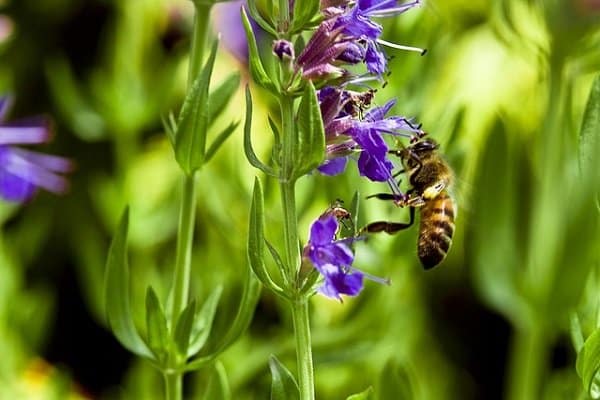
- Latin name – Hyssopus officinalis
- Perennial
- Growing conditions: full sun to partial shade. Doesn’t require frequent watering.
- How to plant: sow seeds in open ground 1/4 inch deep after danger of frost passed. Or sow seeds indoors 6 -7 weeks before last frost for your area and then transplant hyssop to the garden. Be aware that it takes time for hyssop seeds to germinate (up to 3 weeks).
- Hyssop is a good companion plant for grapes, cabbage and cauliflower. it repels cabbage moths and flea beetles.
- Propagation – by seeds, root division, cuttings.
- Days to maturity when planted from seed – 75-85 days.
- Uses: in culinary – hyssop oil and extract are used as a flavoring. Hyssop oil is also used as fragrance in cosmetic products and soaps. In medicine: hyssop is used for digestive, skin, and respiratory problems primarily. More about hyssop health benefits – read here.
- Where to buy: Amazon
22. KOREAN MINT
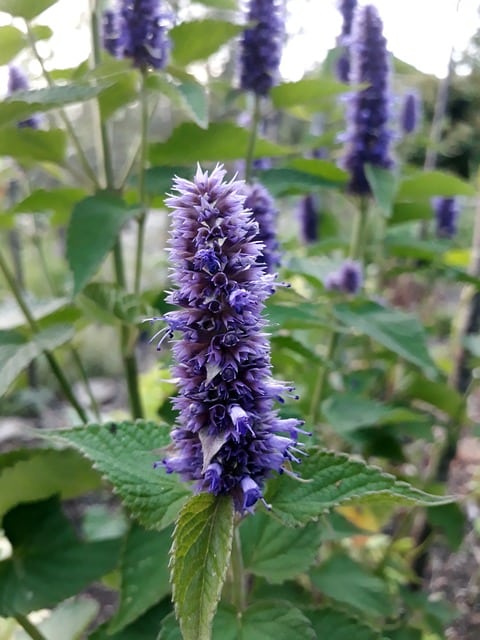
- Latin name – Agastache rugosa
- Also known as: blue licorice, purple giant hyssop, Indian mint, wrinkled giant hyssop, huo xiang, Chinese patchouli, and Korean hyssop.
- Perennial
- Very hardy and easy to grow
- Deer and rabbit resistant
- Can become invasive
- Growing requirements: full sun to partial shade. Tolerant to any soil.
- How to grow: you can start seeds indoors, or plant in open soil outdoors after danger of frost has passed. Seeds need light to germinate, so just scatter them in prepared soil and lightly pat with the palm. Then water gently.
- Propagation – by seeds. root division, cuttings.
- Days to maturity when planted from seed – 80 days.
- Uses: Korean mint leaves have strong anise fragrance and can be added to salad or cooked, but they are very coarse, and I would advise making tea from leaves instead. It is a must have plant to grow in your garden for digestive problems. I have an article dedicated to Agastache Rugoza medicinal benefits and uses.
- Where to buy: Amazon
23. LAVENDER
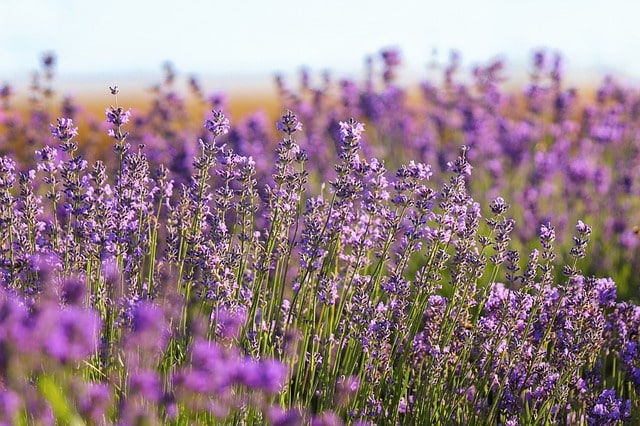
- Latin name – Lavandula
- Perennial
- Growing requirements: lavender needs well drained soil and full sun or partial shade. Ideal climate for lavender is hot and dry.
- Some lavender varieties are frost tender and some can take frost. For example Lavandula Angustifolia Munstead variety can overwinter in Zone 5 (U.S.A.).
- You can grow lavender indoors, particularly the French lavender (Lavandula dentata) varieties.
- How to plant: in my experience, it is pretty hard to grow lavender from seeds. Do yourself a favor and get a potted plant from a nursery or from Amazon. If you are determined to grow it from seeds – your best bet will be the Lady variety.
- You can start to harvest small amounts of lavender when the plant is 2 years old.
- Propagation – by seeds, by rooting the stems in soil, by rooting the cuttings in water.
- Days to maturity when planted from seed: 80 days
- Uses: in culinary – in small quantity can flavor ice cream, also can be added to salad (just be sure to buy culinary grade lavender). But generally, lavender is grown for fragrance rather than for cooking. You can cut fresh flowers for bouquet or dry flowers for potpourri. Lavender essential oil is very helpful for migraine, anxiety, and insomnia. It also can help to heal bug bites and minor burns.
- Varieties to buy: seeds – Lady, Munstead, Lavender collection (Spike, Munstead and Vera), potted plant – 4 perennial live plants, lavender essential oil
24. LEMON BALM
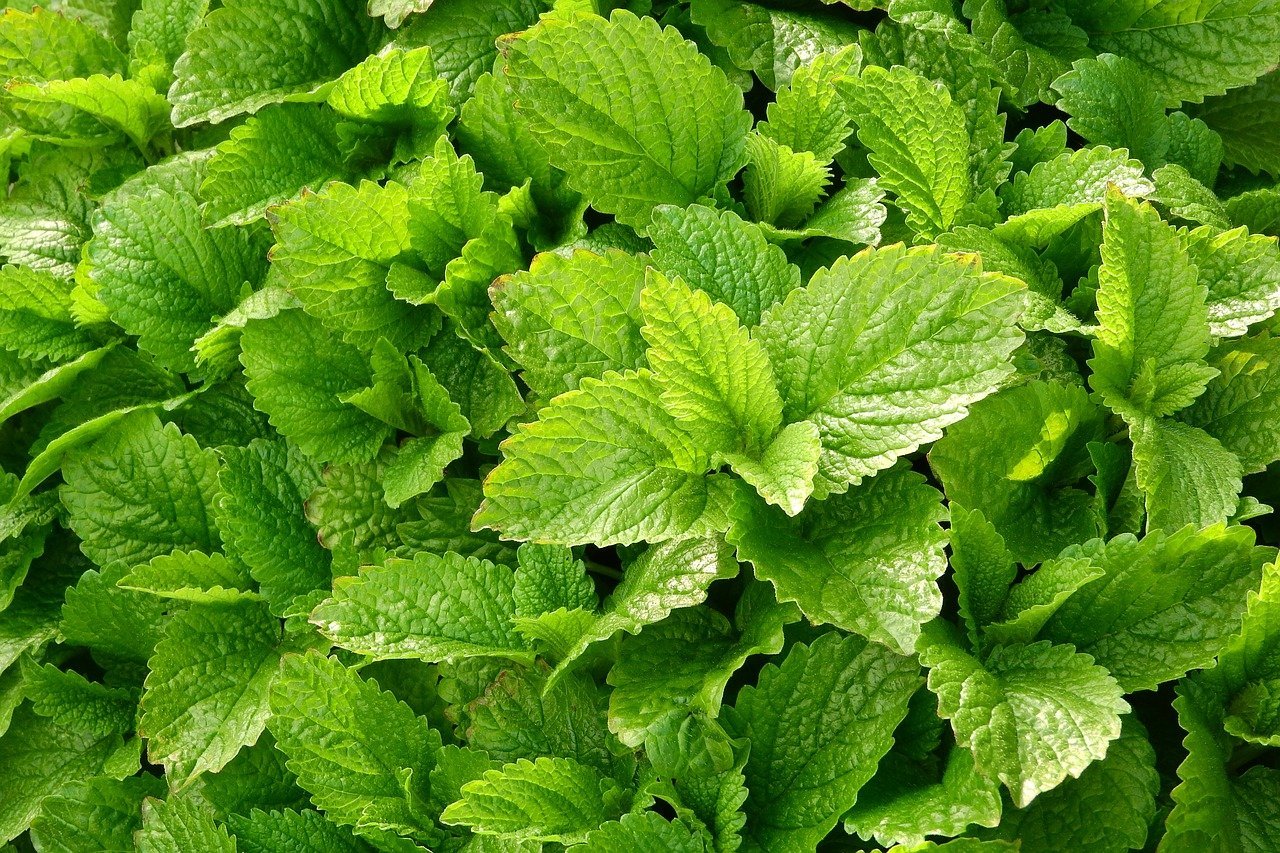
- Latin name – Melissa officinalis
- Perennial
- Cold hardy to 20° F
- Growing requirements: prefers full sun and moist soil. Read how to grow and use lemon balm here.
- How to plant: sow seeds outdoors in open ground after danger of frost, or start indoors 6-8 weeks before last frost and then replant.
- Propagation: by seeds and root division.
- Days to maturity when planted from seed: 80 days
- Uses: tea made from melissa leaves calm anxiety, lift mood, enhance memory, reduce fever and much much more. You can also place a few fresh melissa leaves in cold water to infuse it with lemony flavor. Read about this wonder herb’s medicinal properties here.
- Where to buy: Amazon.
25. LEMONGRASS
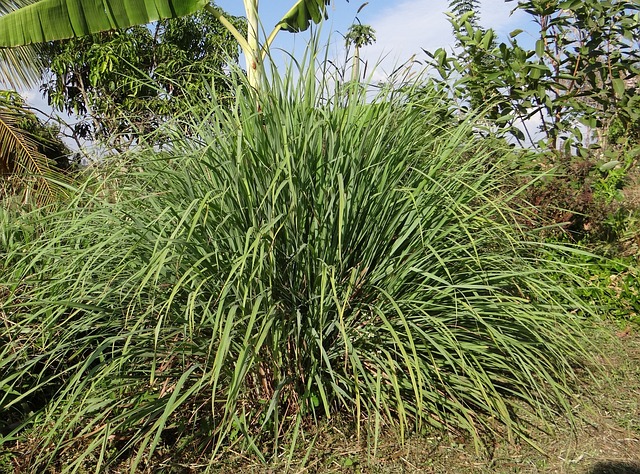
- Latin name – Cymbopogon citratus
- Also known as barbed wire grass, silky heads, Cochin grass, Malabar grass, oily heads,
- Annual, perennial in zones 8 and 9 (U.S.A.).
- Scent resembles lemon.
- Great for growing in pots, because it spreads
- Growing conditions: lemongrass grows well in full sun. Keep it well watered
- How to plant: direct sow seeds shallowly outdoors after danger of frost has passed.
- Propagation: by seeds or division of clump.
- Days to maturity when planted from seed – 75-100 days.
- Uses: culinary – a key ingredient in Asian cuisine. Sliced (and slightly crushed by hand to release flavor) lemongrass can be added to curries, marinades, stir fries, fish, shrimp, soups, stews. It also can be used in cookie and cake recipes. Tea made with lemongrass is very tasty and refreshing and can be enjoyed hot or cold. For medicine – leaves and essential oil are used for pain swelling, fever reduction, inhibiting growth of bacteria. Lemongrass essential oil is also used in soaps, candles, perfumes, deodorant, aromatherapy, insect sprays and repellents.
- Where to buy: Amazon – live plants, seeds, lemongrass essential oil.
26. LOVAGE
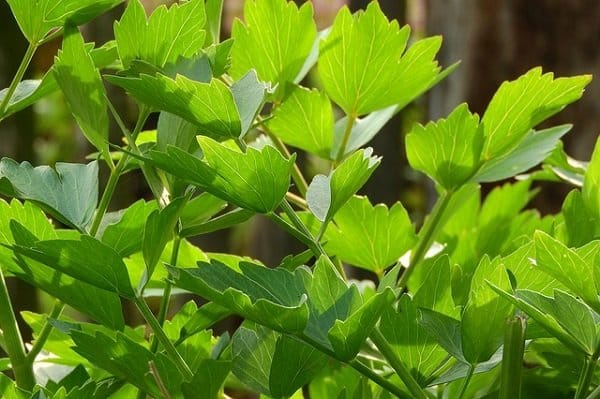
- Latin name – Levisticum officinale
- Perennial
- Domineering plant, can grow 5 feet tall.
- Pretty much resistant to insects and rabbits
- Leaves and flavor remind of celery.
- Growing requirements: likes full sun and fertile soil. Very hardy. Can overwinter even in zone 4 in the U.S.A.
- How to grow: you can plant seeds in spring or autumn. In spring soil should be above 60°F at time of sowing.
- Propagation: by seeds, plant division. Lovage reseeds easily.
- Days to maturity when planted from seed: 80 days.
- Culinary uses: leaves, stalks and seeds are edible. Lovage makes great seasoning for soups. The stalks can be used in dishes instead of celery: this herb tastes great raw in salads, or sauteed and boiled in stews and sauces. Lovage can be dried and frozen for later use. In medicine: used for kidney stones, acne, allergies, bad breath, joint pain.
- Where to buy: Amazon.
27. MARJORAM
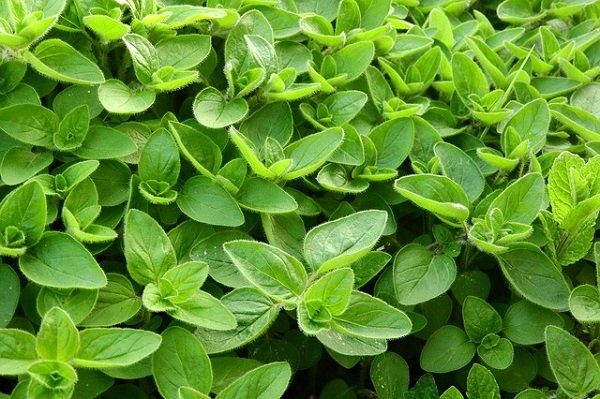
- Latin name – Origanum majorana
- Tender perennial
- Marjoram will overwinter in the garden in zones 9-10 (U.S.A.). You can replant it into a pot in autumn and keep over winter indoors. Then in spring, after danger of frost passes – replant it in the garden.
- Growing requirements: likes sun and well-drained soil.
- How to plant: it’s hard to grow marjoram by direct sowing and generally sowing seeds indoors 6-8 weeks before last frost and then transplanting after the danger of frost passes is recommended. Alternatively, you can buy a potted plant in the nursery and transplant it into your garden.
- Propagation: by seeds, stem cutting or plant division.
- Days to maturity when planted from seed – 80 days,
- Uses: marjoram keeps scent well when dried and can be used in potpourris, wreath making and other crafts. Marjoram is used in culinary for flavoring soups, roasted meats, sauteed vegetables, and marinades. Flowers, leaves and oil are used in medicine, mainly for their anti-inflammatory properties. Marjoram is also used in cosmetics, soaps, perfumes, and lotions.
- Where to buy: seeds, essential oil.
28. MUSTARD
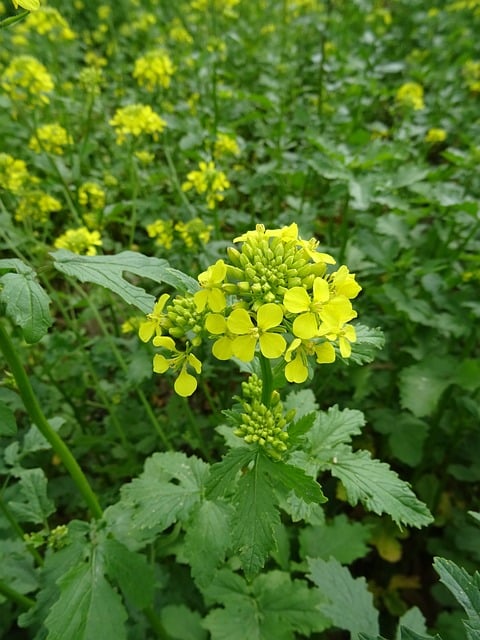
- Latin name – Sinapis alba (for white or yellow mustard)
- Annual
- Growing requirements: mustard prefers well drained rich soil and full sun to partial shade. It thrives in cool weather.
- Do not plant where members of the cabbage family were planted in the past two years.
- How to grow: direct sow seeds shallowly in spring 2-3 weeks before last frost. Dry mustard seeds are harvested in autumn. You can plant mustard in late August for fall harvest of mustard greens.
- Propagation: by seeds. Mustard self sows easily.
- Days to maturity when planted from seed: 45 days.
- Uses: whole seeds are used in pickling and cooking. Seeds can be crushed to make the famous mustard condiment. Tender greens can be eaten fresh and tossed in salads. You can cook mature leaves and serve them on the side. Mustard flowers are edible too.
- Best varieties to buy: Pacific Gold, Florida Brodleaf, Tendergreen.
29. OREGANO

- Latin name – Origanum
- Perennial
- Flavor and cold hardiness varies with cultivar
- Growing requirements: likes sun and well drained rich garden soil.
- How to grow: oregano seeds can be started indoors and replanted, or direct sown after danger of frost has passed.
- Propagation: by seeds, stem cuttings, plant division.
- Days to maturity when planted from seed: 90-100 days
- Uses: in culinary – pairs great with tomatoes. oregano is widely used in salad dressings and tomato sauces, many Italian dishes, pizza, fish, pesto. In medicine – treats headache, muscle pain, stomach upset, and more.
- Best varieties to buy: Greek, Italian
30. PARSLEY

- Latin name – Petroselinum crispum
- Biennial
- Growing requirement: parsley likes sun to partial shade and grows best in rich, moist well drained soil.
- How to plant: parsley transplants poorly, so your best bet is to sow is directly when soil temperature reaches 50°F. Seeds germinate very slowly and can take up to 20 days.
- Propagation: by seeds. Seeds appear on second year plants and self seed easily.
- Days to maturity when planted from seed: 40-60 days
- Uses: in culinary – parsley is an attractive garnish and excellent addition to almost any recipe – it’s used for flavoring soups, stews, sauces, salads, and for making pesto. Flat leaved parsley has a much stronger flavor and is preferred in cooking.
- Best varieties to buy: Italian flat leaf, Moss Curled
31. PEPPERMINT
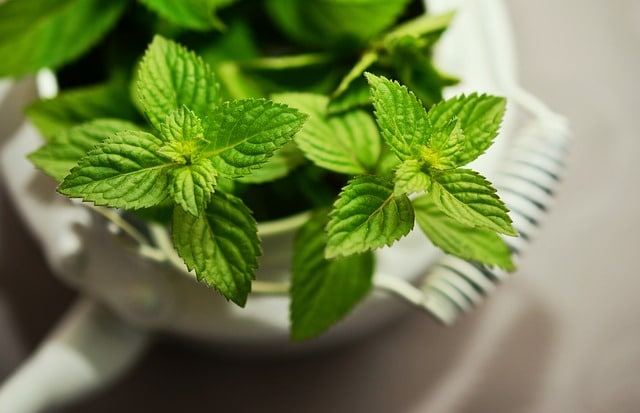
- Latin name – Mentha piperita
- Perennial
- Can be invasive
- Growing requirements: peppermint will do well in full sun to partial shade and rich moist soil.
- How to plant: you should sow peppermint seeds after danger of frost has passed and the soil is above 70°F. Scatter seeds on prepared soil, lightly pat with your palm and water gently. Do not cover seeds with soil. Keep them moist till germination.
- Propagation : by seeds, cuttings and plant division.
- Days to maturity when planted from seed: 80-90 days.
- Uses: peppermint leaves can be used in sauces and salads, but the flavor might be too strong. You most likely will enjoy just refreshing peppermint tea. Peppermint oil is used in food manufacturing to flavor chocolate (Peppermint Chocolove is my favorite!), candies and drinks. As for medicinal purposes, according to scientific studies peppermint exhibits “antimicrobial and antiviral activities, strong antioxidant and anti tumor actions, and some anti allergenic potential.” Other medicinal benefits include aid for digestive problems, herpes, migraine headaches. Be aware, though, that people with gastroesophageal reflux disease shouldn’t be taking peppermint, as according to latest research it can worsen their symptoms.
- Where to buy: Amazon
32. PURSLANE
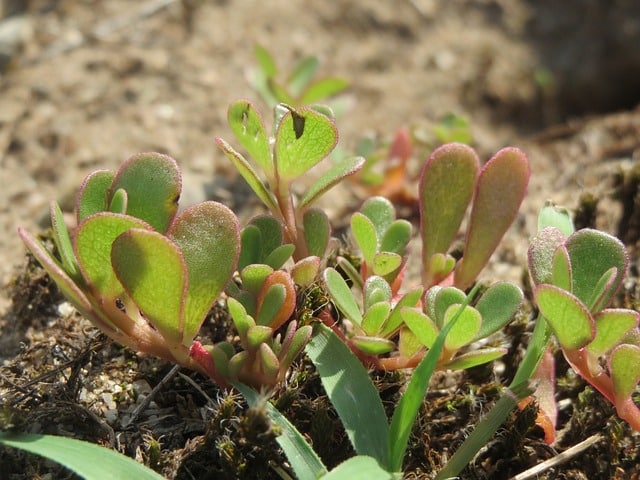
- Latin name – Portulaca oleracea
- Annual
- Growing requirements: full sun. Grows best in cool weather.
- How to plant: purslane can be started indoors but preferably sow it directly in the garden early in spring as soon as soil can be worked. You can plant it again in late summer for autumn harvest. Seeds need light to germinate.
- Propagation: by seeds and cuttings.
- Days to maturity when planted from seed: 30-55 days
- Uses: purslane leaves are rich in omega 3 fatty acids and can be added to salads.
- Best varieties to plant: Organic Golden
33. ROSEMARY
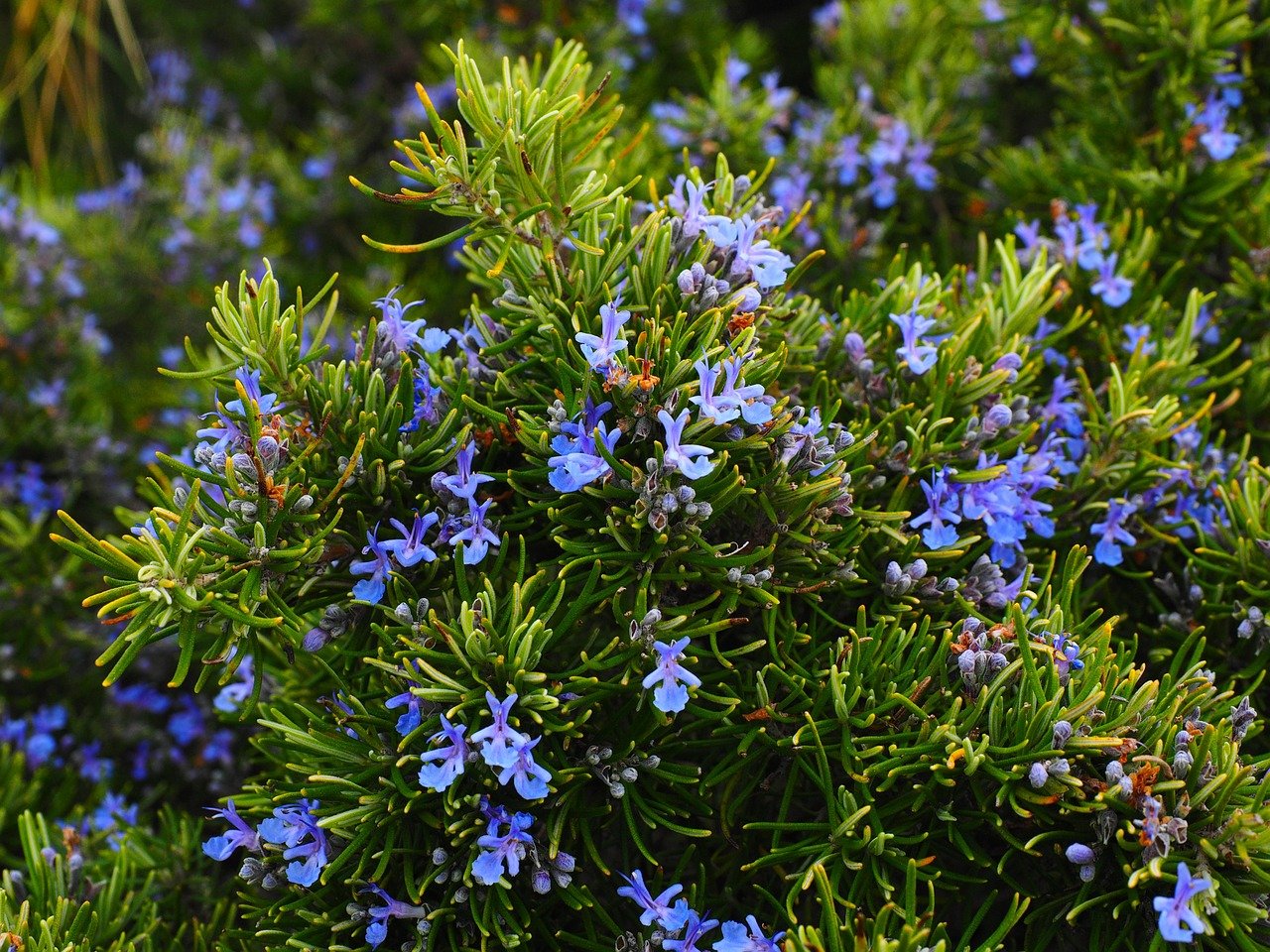
- Latin name – Rosmarinus officinalis
- Perennial
- Growing requirements: likes full sun to partial shade and well drained soil.
- How to plant: rosemary seedlings grow very slowly, so start them indoors early. It is easier to start rosemary plants from cuttings or by replanting a potted plant from a nursery.
- Propagation: by seeds, stem cuttings, layering.
- Uses: culinary – chopped rosemary leaves (needles) are great for flavoring meats, poultry, roasted potatoes and vegetables, some baked goods. Rosemary leaves are also used in marinades and rubs. In medicine rosemary is used for muscle pain, for promoting hair growth, for boosting immune and circulatory system and memory improvement.
- Best ways to buy: 2 rosemary plants in 4″pots, Tuscan Blue (2 pack), rosemary seeds.
34. SAGE
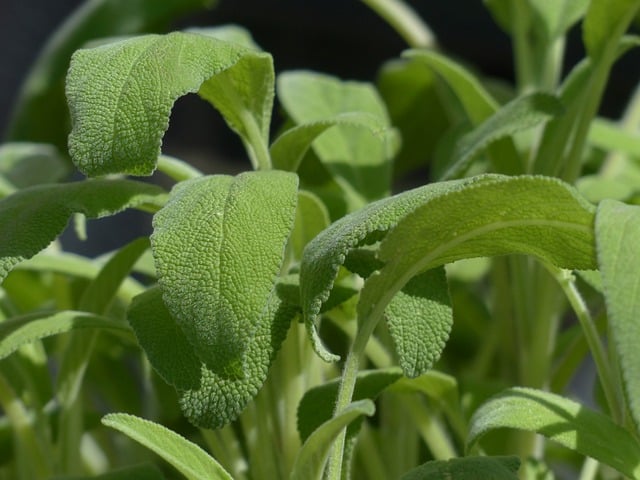
- Latin name – Salvia officinalis
- Perennial
- Growing requirements: sage grows best in full sun to partial shade; likes moist, well drained, rich soil.
- How to plant: buy potted plant or start seeds indoors 8 weeks before last frost date and then replant to the garden after danger of frost passes. Seeds are slow to germinate.
- Propagation: by seeds, stem cuttings, root division, layering.
- Days to maturity when planted from seed: 90–150 days.
- Uses: in culinary – common sage leaves are used in making sausages, are added to roasted poultry, meat and vegetable dishes, bread, dressings, omelets and stuffing. it goes good with beans and tomatoes. Petals from honeydew melon and pineapple sage varieties are edible and can be used in fruit salads. Pineapple sage leaves can infuse cold drinks. In medicine sage is used for cold sores, mental performance improvement, LDL cholesterol reduction, menopause symptoms, obesity, depression and more.
- Best varieties to buy: sage seed collection (White, Common, Victoria blue) Pineapple.
35. SAVORY
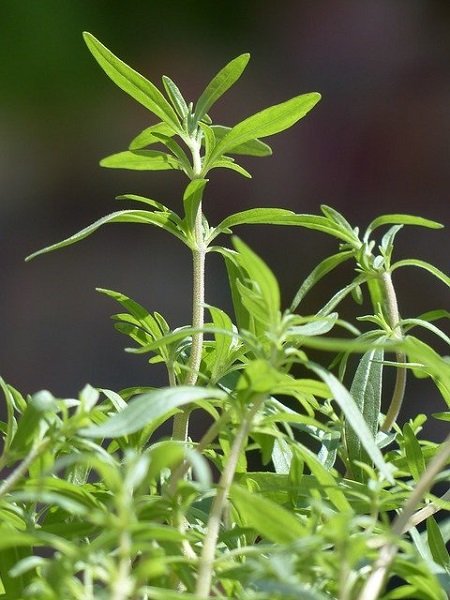
- Latin name – Satureja montana (winter savory), Satureja hortensis (summer savory).
- Also known as Bean herb.
- Summer savory is annual, winter savory is perennial.
- Perennial winter savory is a perfect container plant.
- Growing requirements: savory thrives in full sun and well drained soil. Drought tolerant.
- How to plant: sow summer savory seeds outdoors 1/8 inch deep in the soil after the danger of frost passed. Start to harvest leaves after plant is about 6″ tall. Winter savory is best started indoors and then replanted after the danger of frost. Alternatively you can grow it from cutting from mature plant or buy a potted plant.
- Propagation: by seeds, and winter savory also can be propagated by cuttings.
- Winter savory is great companion plant for beans (protect them from bean weevil) and roses (protects them from aphids and reduces mildew).
- Uses: in culinary – bold peppery savory flavor is great for seasoning soups, stews, meats, bean and cabbage dishes (especially sauerkraut), in marinades. Fresh or dried leaves can infuse vinegar, or can be added to butter. In medicine: according to WebMd summer savory increases sex drive, relieves frequent thirst in diabetics, can be used to treat sore throat, high pressure, insect bites and digestive problems.
- Best varieties to buy: summer savory, winter savory.
36. SORREL
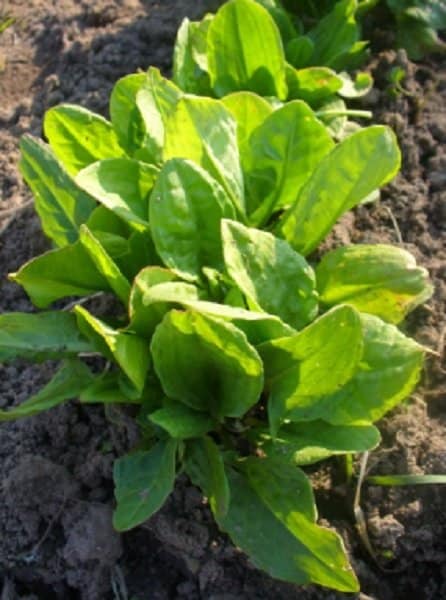
- Latin name – Rumex
- Perennial
- Growing requirements: sorrel likes sun to partial shade, rich soil, and frequent watering in summer time. It takes cold weather well.
- How to plant: you can sow seeds in open ground in spring and fall, or start them in early spring indoors and then transplant. Read detailed instructions in the article How to grow sorrel.
- Propagation: by seeds and plant division.
- Days to maturity when planted from seed: 60 days.
- Uses: leaves can be added to salads, sauces, soups. Learn how to make delicious green sorrel soup that can be enjoyed year around.
- Best varieties to buy: Garden Green, French, Red Veined.
37. SPEARMINT
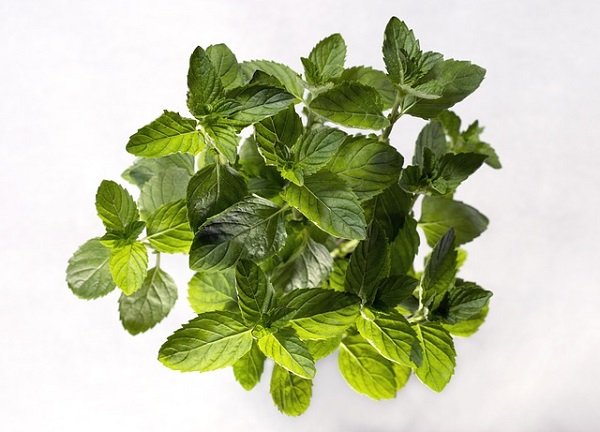
- Latin name – Mentha spicata
- Also known as: garden mint, common mint, lamb mint, mackerel mint.
- Perennial
- Spearmint’s flavor is similar to peppermint, but less pronounced.
- Growing conditions: grows best in partial shade, but can take full sun; prefers rich, moist, yet well drained soil.
- How to plant: sow seeds in warm soil shallowly. Or replant divided plant in autumn or spring. Spearmint reseeds easily and can become invasive.
- Propagation: by seeds, cuttings, plant division.
- Days to maturity when planted from seed: 90 days.
- Uses: in culinary: spearmint pairs well with meats, tomatoes, cheeses, rice. Spearmint leaves steeped in boiling water make great tea. In food industry spearmint is used to flavor candies and drinks. In medicine: it is utilized to ease digestive disorders, headache, sore throat. Leaves can be crushed and applied topically to alleviate swelling.
- Where to buy: Amazon.
38. TARRAGON (FRENCH)
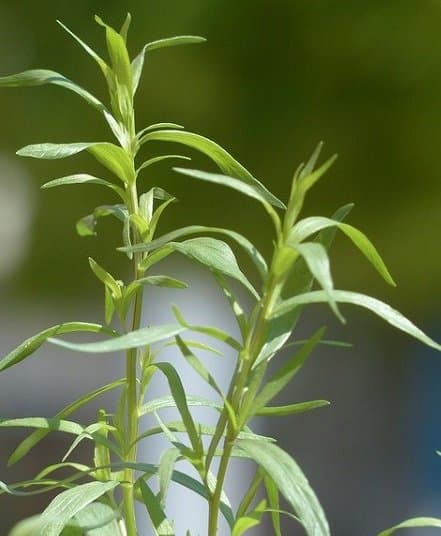
- Latin name – Artemisia dracunculus
- Perennial
- You will want to get French tarragon because it offers the best flavor
- Growing requirements: full sun to partial shade. Needs a loose and well drained soil.
- How to plant: do not start French tarragon from seeds, because this variety doesn’t make viable seed. Get a potted plant, or division or cuttings from mature established plant. Space new plants in the garden 1-2 feet apart, or just grow your tarragon in a pot.
- Remove flower stems when they appear. This will preserve tarragon best flavor.
- Propagation: by stem cuttings, layering or plant division.
- Culinary uses: tender leaves can be mixed in salads or chopped and sprinkled over savory dishes. Tarragon goes well with chicken, fish and vegetables. It is also used in Bearnaise sauce for steak or eggs Benedict. It also can be added to butter.
- Medicinal uses: tarragon is used for digestive problems, colic, poor appetite. It promotes sleep, may lower blood sugar. Read about its health benefits here.
- Where to buy: Burpee
39. THYME
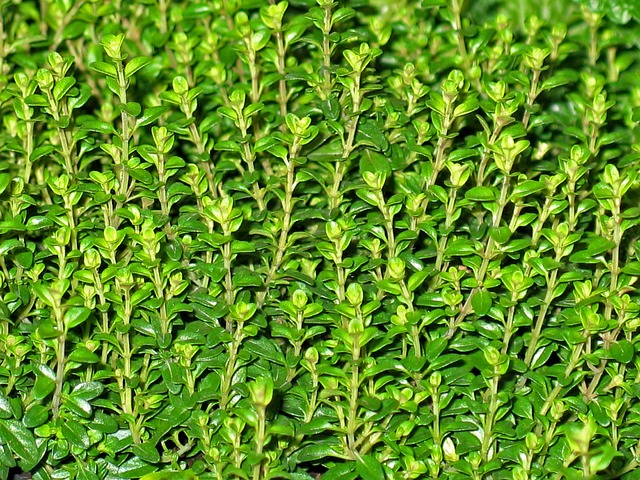
- Latin name – Thymus vulgaris
- Perennial
- Growing requirements: full sun to partial shade and well drained, sandy soil.
- How to grow: it’s better to grow thyme from purchased potted plant or cuttings from mature plant. To grow it from seeds is quite challenging.
- Propagation: by plant division, cuttings, layering, seeds.
- Thyme dries and freezes well.
- Culinary uses: thyme tastes great with almost any food: meats, vegetables, eggs, you name it! It adds great bittersweet flavor to soups and casseroles, marinades and dressings.
- Medicinal uses: leaves, flowers and essential oil of thyme can treat a lot of symptoms: arthritis, sore throat, digestive problems. It improves eyesight, treats acne, muscle cramps, promotes hair growth, helps control blood pressure. Read a research paper on thyme healing properties here.
- Best varieties to buy: English thyme, German thyme, Lemon thyme
40. WATERCRESS

- Latin name – Thymus vulgaris
- Perennial
- Growing requirements: full sun to partial shade and well drained, sandy soil.
- How to grow: it’s better to grow thyme from purchased potted plant or cuttings from mature plant. To grow it from seeds is quite challenging.
- Propagation: by plant division, cuttings, layering, seeds.
- Thyme dries and freezes well.
- Culinary uses: thyme tastes great with almost any food: meats, vegetables, eggs, you name it! It adds great bittersweet flavor to soups and casseroles, marinades and dressings.
- Medicinal uses: leaves, flowers and essential oil of thyme can treat a lot of symptoms: arthritis, sore throat, digestive problems. It improves eyesight, treats acne, muscle cramps, promotes hair growth, helps control blood pressure. Read a research paper on thyme healing properties here.
- Buy watercress seeds for planting: on Amazon
Related reading:
Discover more articles about herbs
Final thoughts on herbs you can grow in your garden
I hope you got inspired and picked a few favorites from the herb garden list to start your outdoor herb garden or expand an existing one with new herbs.
Have you chosen to grow annual culinary herbs that you use most often in cooking in order to have a fresh supply and save money on grocery bills?
Or have you picked perennial herbs to plant once and harvest forever because you don’t have much time to garden?
Or maybe you decided to go easy on yourself and start with a simple organic indoor herb garden kit?
Or have you felt adventurous and selected some herb you never heard of before, like lovage or borage? After all, your garden can’t be “borage” with lovage! 😄
Whatever you chose, I am rooting for you, wish you much luck with your herb garden and lots of satisfaction on your gardening journey.👩🏽🌾
If you found this article useful – be so kind to share with friends.
You have read:
Garden Herbs List: a guide to 40 herbs
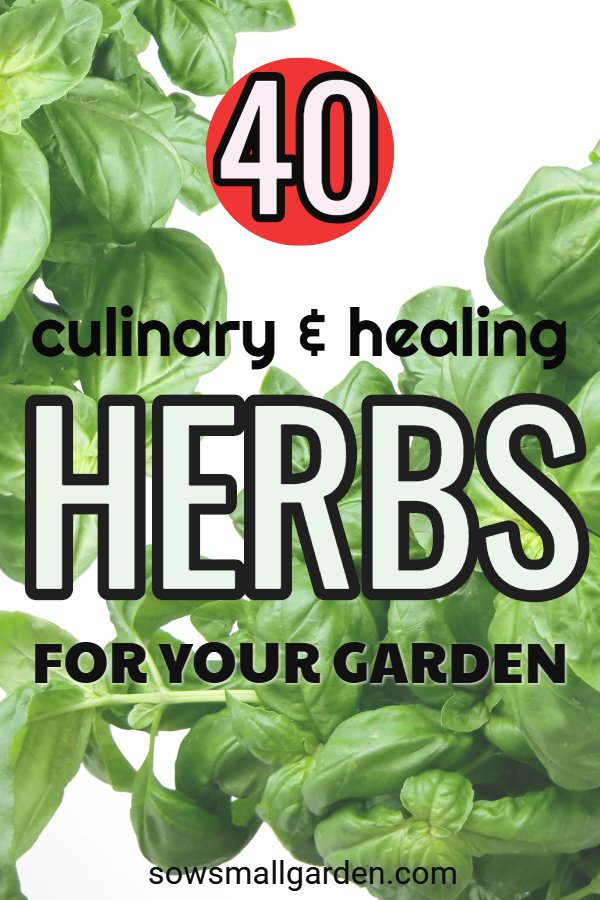
Pin for later reference!


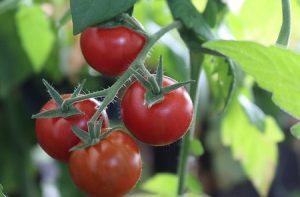
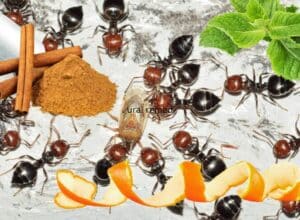
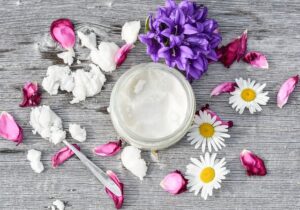
#1: many thanks for your herb list‼️
#2: I am planning an Herbal Community Garden for approximately 25 members. Obviously, expertise will vary but I have been chosen to direct the group with my mini experience in layered gardening. Can you suggest a bit-of-a-plan for me as a newbie “director” ?
Any hints you can offer will be deeply appreciated ‼️
Hilda Feldstein
I am planning a Herbal Community Garden. Have you any suggestions for a group of about 30 members? Obviously, expertise will vary but I shall probably direct the group with my experience in layered gardening.
Any hints will be helpful & deeply appreciated ‼️
Hi Hilda,
Thank you for your kind remarks.
Here’s a brief plan for starting an herbal community garden:
1.Assess the area: Determine the size and location of the garden, taking into account factors such as sunlight, water access, and soil quality.
2. Create a layout: Draw a rough sketch of the garden, including beds and paths, and consider dividing it into sections for different types of herbs.
(You can use this gardening planner https://amzn.to/3X0zbfG for designing your herb beds).
3. Choose herbs: Select a variety of herbs that are suitable for the growing conditions and that will provide a range of uses (such as culinary, medicinal, or ornamental). Make sure to include both perennials and annuals to ensure a continual supply of herbs.
4. Plan for maintenance: Establish a schedule for watering, weeding, pruning, and mulching, and designate responsibilities among the members.
5. Encourage participation: Encourage members to take an active role in the garden, either by sharing their expertise, helping with maintenance, or taking cuttings or seeds to propagate at home.
6. Document progress: Keep records of what has been planted and when, as well as any issues that arise and how they were addressed. This will be helpful for future planning and for sharing information among members.
7. Enjoy: Most importantly, have fun and enjoy the process of creating and maintaining a community herbal garden!
I hope these tips help you get started, and happy gardening!
P.S. Read more about herb gardening here: https://sowsmallgarden.com/herb-gardening/